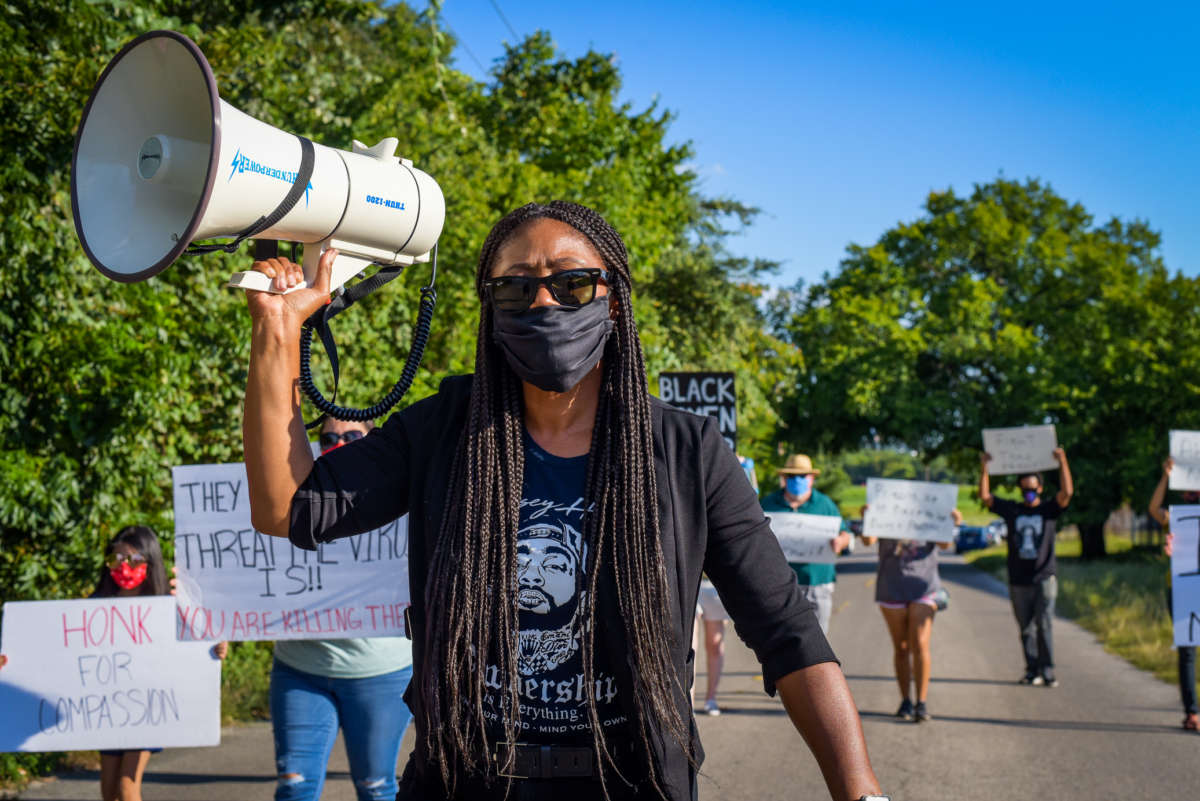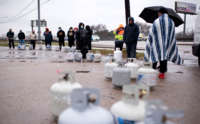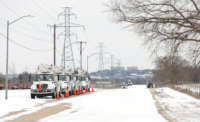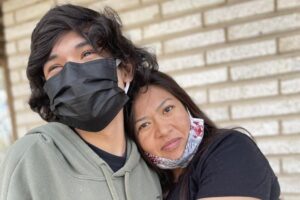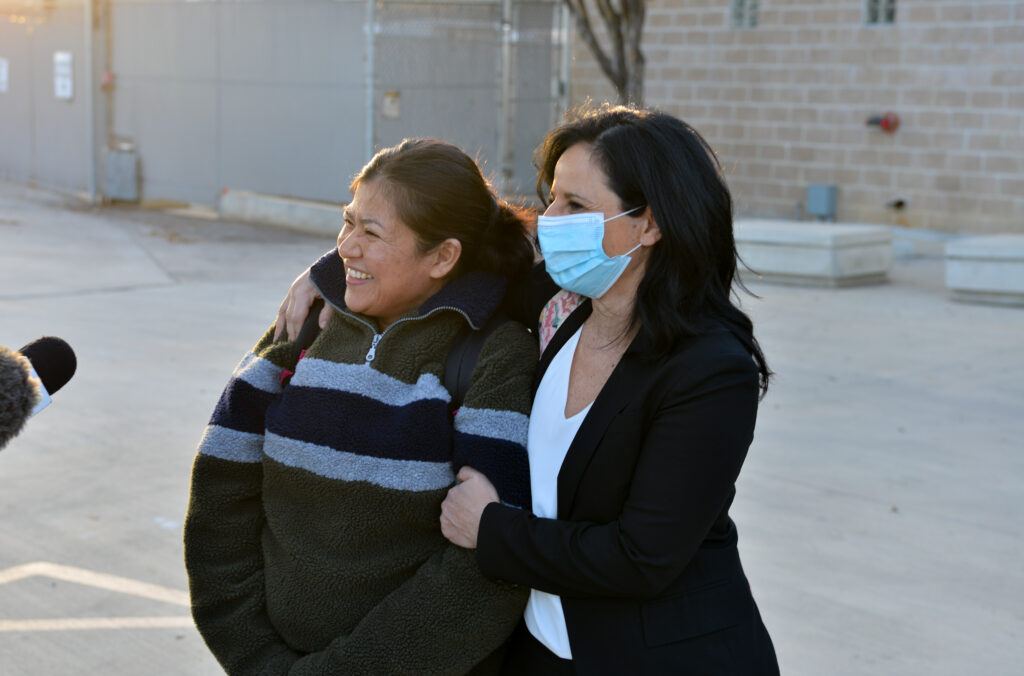Millions of Texans are still suffering after severe winter weather devastated the state’s energy and water systems. About 8 million Texans remain under orders to boil water, and 30,000 homes still have no power. Around 70 deaths have now been linked to the winter storms, including at least 12 people who died inside their homes after losing heat. Republican lawmakers in Texas are facing increasing criticism for their handling of the crisis, their decades-long push to deregulate the state’s energy system, and their unfounded attacks on renewable energy and the Green New Deal. Naomi Klein, senior correspondent at The Intercept and a professor at Rutgers University, says Republicans’ reaction is “because of panic” over their own culpability. “The Green New Deal is a plan that could solve so many of Texas’s problems and the problems across the country, and Republicans have absolutely nothing to offer except for more deregulation, more privatization, more austerity.” Klein also discusses the Biden administration’s early policies on the climate crisis, the dangers of continued fossil fuel development, and her new book, How to Change Everything.
AMY GOODMAN: Today, we’ll start in Texas, where millions are still suffering after severe winter weather devastated the state’s energy and water systems. About 8 million Texans remain under orders to boil water. About 30,000 homes still have no power. President Biden has declared a major disaster in 77 counties. Around 70 deaths have now been linked to the winter storms, mostly in Texas, including at least 12 people who died inside their homes after losing heat, including an 11-year-old boy named Cristian Pavón, who froze to death in his bed in his family’s mobile home in Conroe, Texas. In Sugar Land, Texas, three children and their grandmother died in a fire while trying to stay warm during the blackout.
Republican lawmakers in Texas are facing increasing criticism for their handling of the crisis, as well as their decades-long push to deregulate the state’s energy system. Last week, Texas Senator Ted Cruz faced outcry for flying to Cancún, Mexico, to stay at the Ritz-Carlton while millions of Texans were suffering. Cruz initially blamed the trip on his 10- and 12-year-old daughters. On Sunday, protesters brought a mariachi band to play outside his home in Houston.
Texas Governor Greg Abbott has used the crisis as a way to attack the Green New Deal by falsely claiming the state’s partial reliance on renewable energy was to blame for the blackouts.
GOV. GREG ABBOTT: This shows how the Green New Deal would be a deadly deal for the United States of America. Texas is blessed with multiple sources of energy, such as natural gas and oil and nuclear, as well as solar and wind. But you saw, from what Trace said, and that is, our wind and our solar got shut down, and they were collectively more than 10% of our power grid. And that thrust Texas into a situation where it was lacking power in a statewide basis.
AMY GOODMAN: Meanwhile, New York Congresswoman Alexandria Ocasio-Cortez responded to Governor Abbott’s claim by writing, quote, “The real ‘deadly deal’ is his failed leadership.” Over the weekend, Ocasio-Cortez traveled to Texas to help relief efforts. On Saturday, she volunteered at a food bank in Houston. So far, she’s helped raised over $5 million for Texans impacted by the storms.
To talk more about the crisis in Texas, we’re joined by Naomi Klein, senior correspondent at The Intercept, professor at Rutgers University, along with Juan González. She has just written a piece in The New York Times headlined “Why Texas Republicans Fear the Green New Deal.” And she is author of several books. Her most recent is the one that’s coming out tomorrow, How to Change Everything: The Young Human’s Guide to Protecting the Planet and Each Other. Her previous books include The Shock Doctrine: The Rise of Disaster Capitalism and This Changes Everything.
Naomi, welcome back to Democracy Now! Talk about the Republican leadership of Texas blaming this catastrophe on what hasn’t even happened yet, and that is the Green New Deal.
Naomi, I think we are having trouble right now hearing you. We’re going to go to a break, and then we’re going to come back to you. We’re just having trouble making the connection to you. Naomi Klein, senior correspondent at The Intercept, writing an op-ed piece in The New York Times. Back in a minute.
[break]
AMY GOODMAN: “Texas Sun,” Khruangbin and Leon Bridges. This is Democracy Now! I’m Amy Goodman, with Juan González, as we turn now to Naomi Klein on the catastrophe that has taken place in Texas with the winter storm, about 70 deaths, it’s believed, people suffering major devastation. Thirty thousand homes still have no power. There are still 8 million Texans under orders to boil their water. Naomi wrote a piece in The New York Times, “Why Texas Republicans Fear the Green New Deal.” Naomi, why?
NAOMI KLEIN: Hi, Amy. Hi, Juan. It’s good to be with you today.
Yeah, it’s just been a symphony of voices from the Republican Party pointing the finger at something that doesn’t actually exist anywhere really but on paper, certainly doesn’t exist in Texas. Texas is about as far from a Green New Deal as you can possibly get, seeing as a Green New Deal is a plan to bring together the need to get off fossil fuels in the next decade to radically decarbonize our energy system, and, as we know, fossil fuels are still king in Texas. It’s a plan to marry that huge infrastructure investment in the next green economy with a plan to battle poverty, to create huge numbers of good, union, green jobs, to take care of people. It’s a plan to have universal public healthcare and child care and a jobs guarantee. So it’s all the things that are not happening in Texas, because there isn’t just this extreme weather, which many scientists believe is linked to our warming planet — you know, you can’t link one storm with climate change, but the patterns are very clear, and this should be a wake-up call — but Texas is also suffering a pandemic of poverty, of exclusion, of racial injustice. It certainly doesn’t have a Green New Deal.
And we’ve heard this messaging, I think, because of panic, frankly, because the Green New Deal is a plan that could solve so many of Texas’s problems and the problems across the country, and Republicans have absolutely nothing to offer except for more deregulation, more privatization, more austerity. And so they have been frantically seeking to deflect from the real causes of this crisis, which is an intersection of extreme weather, of the kind that we are seeing more of because of climate change, intersecting with a deregulated, fossil fuel-based energy system. And that is the truly catastrophic intersection. And layered on that, you have all of the injustices and inequalities that mean that this doesn’t impact everybody equally by any means. It’s an extremely racially unjust catastrophe, as every catastrophe in the United States is.
JUAN GONZÁLEZ: And, Naomi, could you talk a little bit about the — it’s basically a right-wing extremism when it comes to energy policy that’s been practiced in Texas — the origins of the deregulation movement that Texas pioneered? And also, the other wrinkle in this —
NAOMI KLEIN: Sure.
JUAN GONZÁLEZ: — is this notorious independence streak, that Texas not only wants the United States to be energy independent, the state of Texas wants to be independent from the rest of the U.S. electrical grid, so that other states couldn’t come to its support in this time of crisis.
NAOMI KLEIN: Sure. You know, in headlines, I heard you playing a clip of Alexandria Ocasio-Cortez’s trip to Texas and the fact that she raised — helped raise, I believe, $5 million, to this point. And, you know, she’s been very clear that she doesn’t believe that charity is the solution to these systemic failures. And, of course, she is probably the person who’s most closely associated with the calls for a Green New Deal in government. But I think that what she is trying to show with this action is that government should be there to take care of people, that we should have each other’s backs, particularly in a crisis.
The ideology that has governed Texas now for at least four decades is an ideology, I think, best encapsulated by Ronald Reagan’s famous phrase, “The nine most dangerous words in the English are ‘I am from government, and I’m here to help.’” And, you know, I think it is worth pausing over that, because that sort of glib slogan, that people should be afraid of a government that’s there to help, when you have a catastrophe like the one that is unfolding in Texas, but, more broadly, the pandemic everywhere, it’s really quite chilling, because people need a government that is there to help. And so, in Texas, they just took this to the extreme.
And so, it goes back further than the 1990s, but a series of fateful decisions were made in the late 1990s, when Enron — blast from the past, and now defunct, but this scandal-plagued energy company headed by the late Ken Lay — led this successful push, under then-Governor George W. Bush, to radically deregulate Texas’s electricity sector. And they won, is the bottom line. And as a result, decisions about the generation and distribution of power were stripped from regulators in Texas and handed over to private energy companies, on the basis of this logic that what’s good for industry will be good for everyone else, prices will be lower, there will be maximum competition. So you have all of these private players competing with each other, and, as you said, Juan, they are, quote-unquote, “independent” from the rest of the grid.
You know, I see some really interesting parallels with what has happened with COVID, because when you hand over essential functions of the state to private companies, whether they’re healthcare companies or whether they’re energy companies, what they seek to do is make maximum profits, and you do that through, quote-unquote, “efficiency.” Now, what does “efficiency” mean in practice? It means you take out all the slack in the system, because you’re wringing out profits, maximum profits, at every turn. So, when it comes to something like healthcare or elder care, that means you don’t want to have a single empty hospital bed or a single empty bed in an elder care facility, because that’s an inefficiency. But then, if you have a shock, like a pandemic, you have no slack in the system to absorb that shock, and you have disaster, right?
What we’ve seen in Texas is something very similar with energy, right? There’s no slack in the system. There’s no built-in redundancies, because if you’re plugged into the national grid, if you have a shock in your state or in one location, then energy from somewhere else that is not having a shock is able to come in and cover for you. In Texas, they took out all of those redundancies, and so then you have a weather shock that puts stress on the system, knocks out capacity, and also there’s a surge in demand because it’s freezing and everybody wants more energy, and it just blows the whole system out, in the same way that the pandemic blew out any capacity in the healthcare system, if that makes sense.
So, unsurprisingly, these private companies prioritized short-term profit over costly investments in maintaining the grid, in winterizing the grid for an extreme event. They took out all the built-in redundancies. And today, Texans are at the mercy of regulation-allergic politicians who failed to require that energy companies plan for shocks, like the one they’re experiencing right now and like the ones, frankly, we are going to see more and more of because of our destabilized climate.
JUAN GONZÁLEZ: And, Naomi, as you’ve often documented, every crisis brings an opportunity for other capitalists to profit. Who will benefit from this crisis? Can you talk about the shale gas company, for instance, Comstock Resources?
NAOMI KLEIN: Right, yeah. Look, energy companies are — it’s a windfall, as they are proudly telling their investors. Comstock Resources is a shale gas company. And on an earnings call last Wednesday, their chief financial officer said, “This week is like hitting the jackpot with some of these incredible prices,” because, once again, there are no protections for consumers.
So, all of this was sold to Texans based on this idea that it was going to lower their energy costs. But there’s no protections from costs going up when you have a huge surge in demand like they’re experiencing right now. So, people who were fortunate enough not to lose their power — and I know you’re going to be talking about this more later on in the show, but people who had their power stay on are now being hit with these absolutely exorbitant electricity bills. Once again, no protections for them, because it’s a market free-for-all, which was the vision from the start. And so you have politicians like Ted Cruz now banging their hands on the table, saying, “This is wrong! What is it? What are these huge bills?” It’s entirely legal. This is the result of the energy system that they built.
AMY GOODMAN: So, Naomi, you have the former governor, Rick Perry, who was also the secretary of energy of the United States, retweeting an article, saying, quote, “If we humans want to keep surviving frigid winters, we are going to have to keep burning natural gas — and lots of it — for decades to come.”
NAOMI KLEIN: Yeah.
AMY GOODMAN: He also went on to say, “Texans would be without electricity for longer than three days to keep the federal government out of their business.” I don’t know if that’s why Senator Cruz fled to Mexico, to keep the federal government out of Texas. But this moment, where you have this older, white, wealthy Republican leadership of Texas — deregulation going back to the ’30s, right? I mean, for people to understand, you’ve got the Eastern grid, the Western grid and Texas. That’s what you have, the electric grids in the United States. And El Paso is not a part of the Texas independent grid, and so they did so much better.
NAOMI KLEIN: Right.
AMY GOODMAN: But what this means for that leadership and the young leadership, that has been fighting for a Green New Deal, that has been recognizing COVID as a scientific reality, that Texas was disastrous in dealing with?
NAOMI KLEIN: Sure. I mean, there’s a very strong youth-led movement in Texas that has been calling for a Green New Deal for a while. And I think that they’re going to be calling for that with greater confidence and greater volume and greater determination in the weeks and months to come, which is why, in The New York Times piece that you mentioned, I described all of this deflection as a form of panic, because we know that — they know, and we know, that they have no solutions for the problems that they have created. All they have to offer Texans is more deregulation, more privatization, more austerity, more disaster capitalism. As usual, we’re seeing waves of criminalizing people who protest against fossil fuel companies. You know, they don’t have solutions to real problems, which is why they’re just making things up. And we’re seeing that on absolutely every level.
But, you know, I want to come back to what you were saying about this rift between the leadership, who really don’t have to worry about their power, are taking vacations in the middle of this, are clearly not worried, are making these glib statements, like, “Oh, yeah, we’ll live without power for much longer, if necessary.” They’re not the ones without power, right? There’s so much inequality, as I said earlier, whenever there is any kind of disaster in the United States, it follows racial fault lines, economic fault lines.
And I think that we should think about Ted Cruz’s ill-fated trip to Mexico not as a, quote-unquote, “mistake,” as he now describes it, but, in a way, as a metaphor, Amy, a metaphor for how these politicians actually think about the climate crisis. They don’t think it’s a hoax. They just say that publicly. They know it is real. You know, these are people with deep ties to the oil and gas industry, and the oil and gas industry is, in lots of ways, benefiting from the climate crisis, because there’s melting in the Arctic. It’s opening up trade routes because of that. They’re having to adapt all kinds of their own infrastructure to deal with the reality of climate change. They don’t really genuinely believe that it isn’t real. They’re on the frontlines of it in lots of ways. What they believe — and I think we’ve talked about this before on the show — is that this is somebody else’s problem. They believe that their wealth, their power and their privilege will protect them from the worst of its effects. And if we want to know what that looks like, it looks like Ted Cruz boarding a flight to Mexico in the middle of a disaster to go to the Ritz-Carlton in Cancún.
And that is something that I’ve tracked over the years in this privatized response to crisis, right? So, it isn’t just the systematic neglect and deregulation of the private sphere, of the infrastructure that regular people, everyday people, have to depend on in a crisis. It’s that they’re simultaneously building their privatized kind of rescue bubbles. You know, there was a short-lived airline that I wrote about in The Shock Doctrine many years ago, short-lived because it was ahead of its time. It was called HelpJet. It was launched in Florida. It was a private jet airline that would send a notice to people in Florida when their beachfront homes were at risk from a hurricane. And their slogan was something like “Turn a disaster into a luxury vacation.” This company would send a limousine to come pick you up, take you to the airport and jet you out on a private jet, make your reservations at a luxury resort. And that was their idea of how to deal with a disaster. Now in California when there are wildfires, there are private firefighters that come to protect the mansions and the wineries.
So they don’t see themselves as part of the public infrastructure that they’re systematically allowing to degrade. They believe they’ll be fine. What does that look like? It looks like Ted Cruz flying off to Mexico. Now, he got caught. He’s calling it a mistake. It’s actually a metaphor for the fact that they don’t believe they have to deal with the effects of the disasters that they themselves are creating.
JUAN GONZÁLEZ: And, Naomi, if we could, the Biden administration. I’m wondering if you could give us a brief take on how it’s been responding to this crisis and also the initial — in its initial weeks in terms of its climate policy.
NAOMI KLEIN: You know, I think that there are obviously some good signs when it comes to climate policy — the canceling of the Keystone XL pipeline. You know, I think, most significantly, we are seeing much more coordination between different arms of the government, and this has been something that’s really been lacking in previous administrations, where climate has just been treated as a narrow pollution issue that should be dealt with by the EPA and the Energy Department. And I think one of the most significant things is this sort of commitment to having individuals whose job it is to make sure that all the different arms of the government, all the different departments and agencies, are talking to each other.
But, you know, Keystone needs to be more than just one pipeline canceled. It needs to be a principle. And the principle is, we cannot be building new fossil fuel infrastructure. I know you’ve covered the intense battles against Line 3, against the Dakota Access pipeline. All of this new fossil fuel infrastructure needs to be canceled. We cannot be locking in new fossil fuel infrastructure when we need to be winding down, if we’re going to get off fossil fuels in a decade, which is what scientists have told us we need to do. So, there are good signs, but, unfortunately, like, we’re still at the level of symbolism. We are not at the level of actually doing what is necessary to prevent the kind of catastrophic warming that we can’t survive. We’re already in the era of climate shock, of climate disasters. But if we don’t get off the road we are on, if we don’t swerve, then we are going to be dealing with shocks that we can’t adapt to.
You know, I don’t think that the — I think we need to be talking about whether energy belongs in private hands at all, whether this is just too much of an essential service and also whether we just need too much change too quickly to have the private sector involved in energy in the first place. And these are the sorts of policy discussions that the Biden administration, because of its ties to the private sector, is really not willing to engage in yet. But they’re going to be under huge pressure, I think, particularly after this, by the progressive wing of the party, by outside climate justice movements. And we’ll see what happens, because they’ve already moved a lot more than they wanted to move. Biden is doing more than his campaign was promising, certainly, in the early days. So, we’ll see. They are under pressure. They have moved, and they’re going to need to move further.
AMY GOODMAN: And, Naomi, we only have 30 seconds, but, of course, the youngest are also such extreme victims of this catastrophe. We learned about 11-year-old Cristian, who went outside, saw snow for the first time, to play in the snow, came inside and froze to death. We hear these stories as part of the 70 people who have died as a result of the storm. You have a book that’s coming out tomorrow. Tonight, you’ll be doing a big virtual event with Sunrise Movement at the Brooklyn Public Library. Your book, How to Change Everything: The Young Human’s Guide to Protecting the Planet and Each Other. Your final thoughts, on why you wrote this book?
NAOMI KLEIN: Thank you, Amy. Yeah, at this event tonight, we’ll also be joined by Tokata Iron Eyes, who is a young woman who is from Standing Rock and was one of the young people who helped start that incredible movement in Standing Rock against the Dakota Access pipeline, and is just one example of the fact that young people now — and by “young people,” I’m not just talking about university students, I’m talking about middle school students and high school students — are truly the heart and soul of the climate movement right now.
And that’s why I wrote the book. I wrote the book for this incredible generation, who have been leading climate strikes, who have been pushing politicians, speaking truth in incredible ways, like Greta, who you’ve talked about so much on the show, but is part of this amazing generation of millions of young people around the world. And there aren’t a lot of books that take them seriously, that treat them with the dignity to believe and understand that they’re ready for the truth because they’re living it and they need some tools, some intellectual tools, some facts, some figures, to fight for the future that they deserve. So that’s why I wrote the book. And I’m so excited to have these opportunities to interview young people about why they have built this amazing movement. And that’s what we’re going to be doing tonight and over the next few weeks.
AMY GOODMAN: Naomi Klein, senior correspondent at The Intercept, professor at Rutgers University. We’ll link to your New York Times op-ed piece headlined “Why Texas Republicans Fear the Green New Deal.” Her latest book is coming out tomorrow. It’s titled How to Change Everything: The Young Human’s Guide to Protecting the Planet and Each Other.
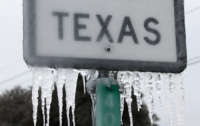



 (@cmclymer)
(@cmclymer) 


